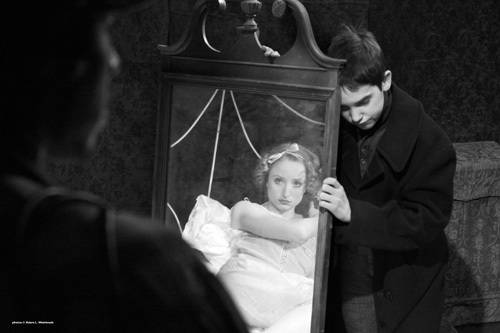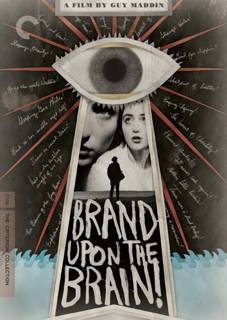
A friend of mine and a reader of this column suggested a couple weeks ago that I actually write about movies that I like, instead of watching new releases and complaining about them, which seems to happen too often. He should be thankful that I never got around to writing my review of Hamlet 2, which I forced myself to watch a couple weeks ago when it came out on DVD. So what I’ll be doing from now on is telling you not just about the movies which came out this week, but also the movies that are worth watching, new or otherwise. We’ll start this week with a recent release of a film which premiered at the Toronto Film Festival a couple years ago, Guy Maddin‘s Brand Upon the Brain!.
Maddin is a director with no antecedents, at least not in the last 80 years. His Brand Upon the Brain! is a hectic mix of nearly every major genre of silent cinema, incorporating acting, editing and filming techniques from melodrama, expressionism, surreal avant-garde and Soviet montage, with a set design and in-camera effects that are most frequently reminiscent of the fantasies of Georges Méliès. The apparent danger of such an overreaching amalgamation of styles is that the substance of such a film, if there is one, could get lost in the mix.
But for the accomplished postmodern artist, the substance is in the style, and Brand Upon the Brain! manages to be as personal as it is experimental and stylized. The main character’s name, after all, is Guy Maddin, played by Erik Steffen Maas as an adult and Sullivan Brown as a child. Calling Brand autobiographical would be a stretch, as it seems to take place somewhere outside the constricting realm of time — and as it’s reasonable to assume the real man’s father is not a mad scientist. But Maddin-the-filmmaker is obviously using metaphor and hyperbole to express something about himself, even if Maddin-the-character isn’t quite the same person.
 The film starts as Maddin is called back to his childhood home by a letter from his mother, received as he is literally adrift on a small raft on an unspecified body of water. He returns to his childhood home, a lighthouse that was also an orphanage run by his parents. The narrator, a woman with an unspecified accent which probably originated in the film’s fictional country of “Rumania” (i.e., “to ruminate,” yet another example of the film’s enthusiastically over-obvious metaphorizing), switches back and forth between omniscience and melodramatic first person as Guy revisits his childhood in the lighthouse. The narrator remains with us as we flash back to Guy’s childhood, as he loses his innocence to the often frightening spectre of adult sexuality and lost love.
The film starts as Maddin is called back to his childhood home by a letter from his mother, received as he is literally adrift on a small raft on an unspecified body of water. He returns to his childhood home, a lighthouse that was also an orphanage run by his parents. The narrator, a woman with an unspecified accent which probably originated in the film’s fictional country of “Rumania” (i.e., “to ruminate,” yet another example of the film’s enthusiastically over-obvious metaphorizing), switches back and forth between omniscience and melodramatic first person as Guy revisits his childhood in the lighthouse. The narrator remains with us as we flash back to Guy’s childhood, as he loses his innocence to the often frightening spectre of adult sexuality and lost love.
The narration and the frequent, obviously dubbed sound effects are what clearly mark the film as originating sometime after the 1920s, but Brand is mostly a visual movie. Its real strength lies in Maddin’s expression of Guy’s unconscious fears and conscious longings with quick cuts, classic special effects and nearly “subconscious” intertitles. The film’s merging of fantasy, reality and memory is realized in the character of Wendy Hale (Katherine Scharhon), Guy’s childhood love who is both “real” and the fictional subject of a series of detective novels he reads. In love with Wendy, who soon disappears (actually, she has just disguised herself as a boy because she is secretly in love with Guy’s sister, Sis), he convinces himself that everything happens twice, that memory and the heart can serve to resurrect the dead and lost moments.
Maddin’s films’ hyper-cinematic style can get tiring, but Brand Upon the Brain! clocks in at a digestible 97 minutes. It’s a fascinating exploration of memory and the unconscious through a self-consciously cinematic apparatus, an intensely personal story that happens to also be one of the formally smartest in recent years.
NEW RELEASES FROM THE BOX
Mirrors
This mid-August release didn’t fare well at the box office, probably because the trailer, unable to communicate anything but the film’s flimsy premise, made the film look dreadful. But director Alexandre Aja, in my book, deserves a chance after the delightfully suspenseful and gory High Tension (Haute Tension, 2003) and The Hills Have Eyes remake (2006). If you’re in the mood for a disturbing but goofy gorefest, this might be worth renting.
Swing Vote
Another August release (August is one of those months where Hollywood sends movies to die), I actually walked out on this flat, uninspired “topical” comedy, so I can’t tell you if it gets any less flat or any more inspired after the half hour I saw of it. But it’s definitely super-topical the whole way through!
My Best Friend’s Girl
Jason Biggs, Dane Cook and Kate Hudson, together to make my life miserable. This movie looked so bad, even star Dane Cook had to complain. Of course, Cook doesn’t do himself any favors in his attack on the film’s advertising campaign, managing to make fun of both the disabled (Bell’s Palsy sufferers) and the unfortunate (Britney Spears’s vagina).
NEXT WEEK ON FROM THE BOX
Is Max Payne the best video game movie ever? Would this be anything to brag about? Is there a scene in which Mark Wahlberg talks to an organism incapable of language, only to discover it’s made of plastic? The joke’s on Marky Mark, next week in From The Box.








